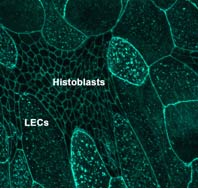Inhalt
Dr. Mirka Uhlirova
Institute for Genetics
+49 221 470 2713
+49 221 470 5185
Cell migration, a key process in development of an organism
Directed cell migration plays a fundamental role during animal development, tissue regeneration and wound healing. In response to migratory cues cells polarize and their cytoskeleton undergoes extensive remodeling facilitating cell shape changes. Moving cells also interact with surrounding environment via modulating adhesion to their immediate neighbors and to the substrates they are crawling on. The entire migratory process must be tightly controlled temporarily and spatially on the level of the individual cells, tissues and the whole organism. Deregulation of cell movement can lead to developmental anomalies and drive pathological processes such as tumor invasion.
Our lab has been focused on understanding the molecular mechanisms that control cell migration. We study how signaling pathways cooperate to polarize cells, regulate cell-cell contacts and cell-substrate adhesion and how they modulate cytoskeleton dynamics. The fruit fly, Drosophila melanogaster, offers an attractive possibility to study the process of cell migration in vivo using advanced genetic and imaging tools.
In the proposed project we would like to characterize a gene network regulating epithelial cell replacement during abdominal morphogenesis. The formation of the adult fly abdomen during metamorphosis relies on gradual replacement of the large polyploid larval epidermal cells (LECs) by imaginal diploid cells called histoblasts. The histoblasts divide, migrate from the lateral nests and intercalate between the LECs. To free space for the histoblasts, LECs are extruded from the epithelial monolayer.
Figure: Confocal image of pupal abdominal epidermis. The histoblast nest is surrounded by large larval epidermal cells (LECs) 18h after puparium formation (APF). Cell membranes are visualized by ubiquitous expression of DE-cadherin::GFP fusion protein.
We have performed an unbiased forward genetic screen employing transgenic RNAi line collection to identify new regulators of abdominal morphogenesis. We attempt to characterize these novel candidates and their role in process of epithelial cell replacement in detail. Nest of histoblasts surrounded by large larval epidermal cells (LECs) 18h after puparium formation (APF). Cells outlines are visualized by ubiquitous expression of membrane specific fluorescent marker.

